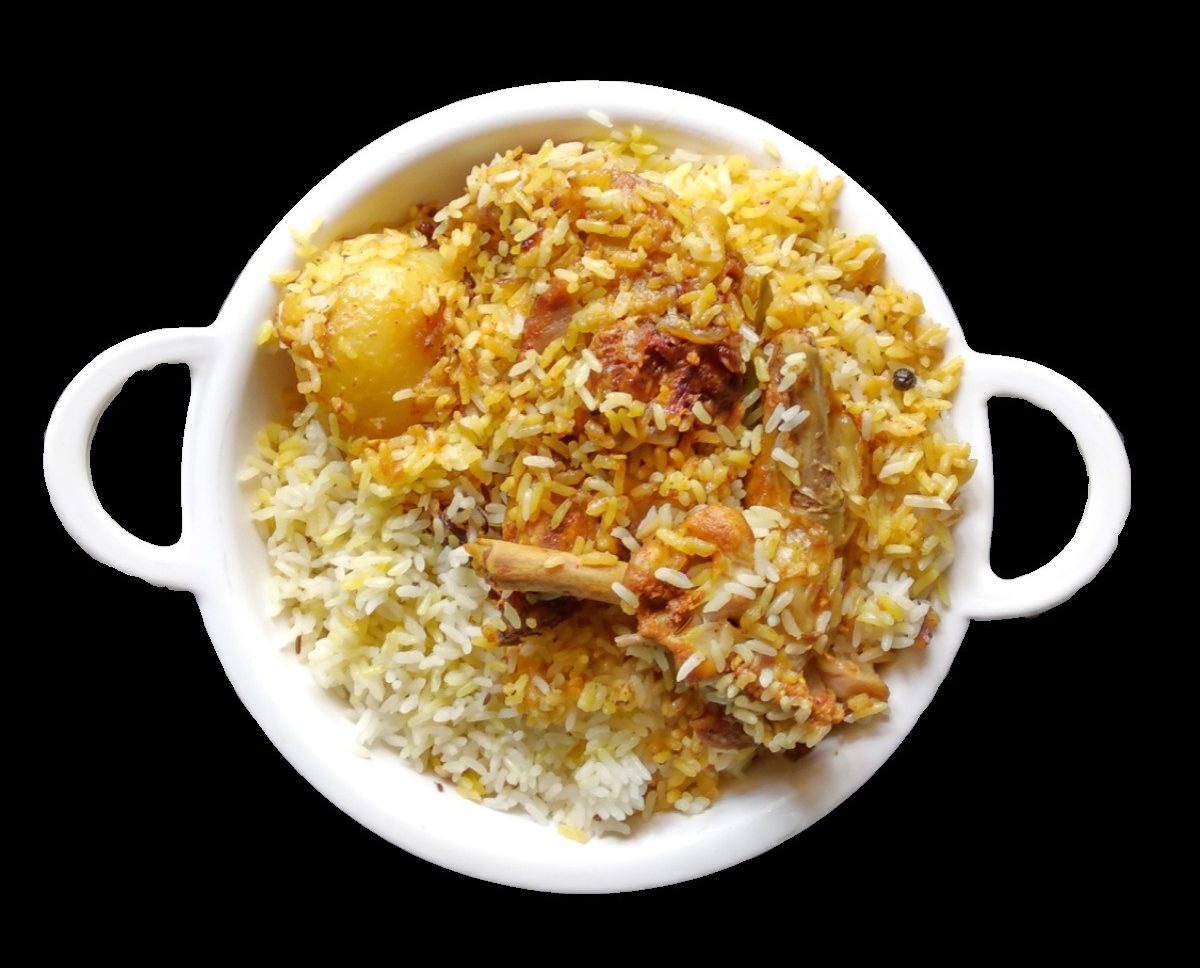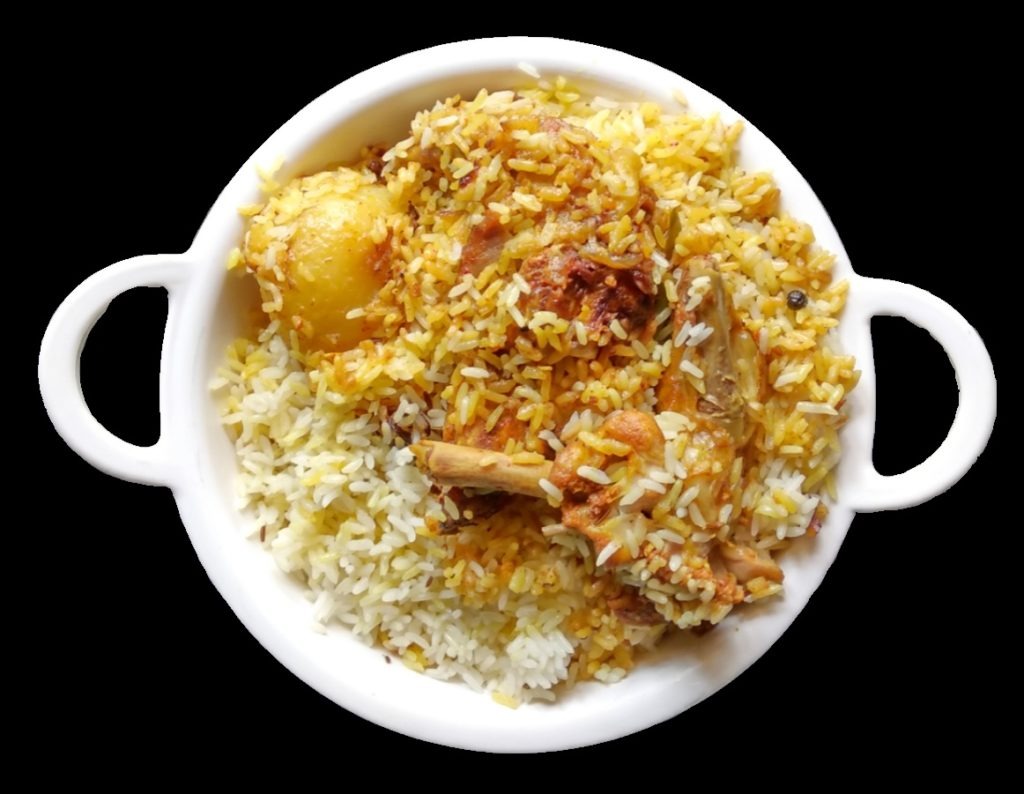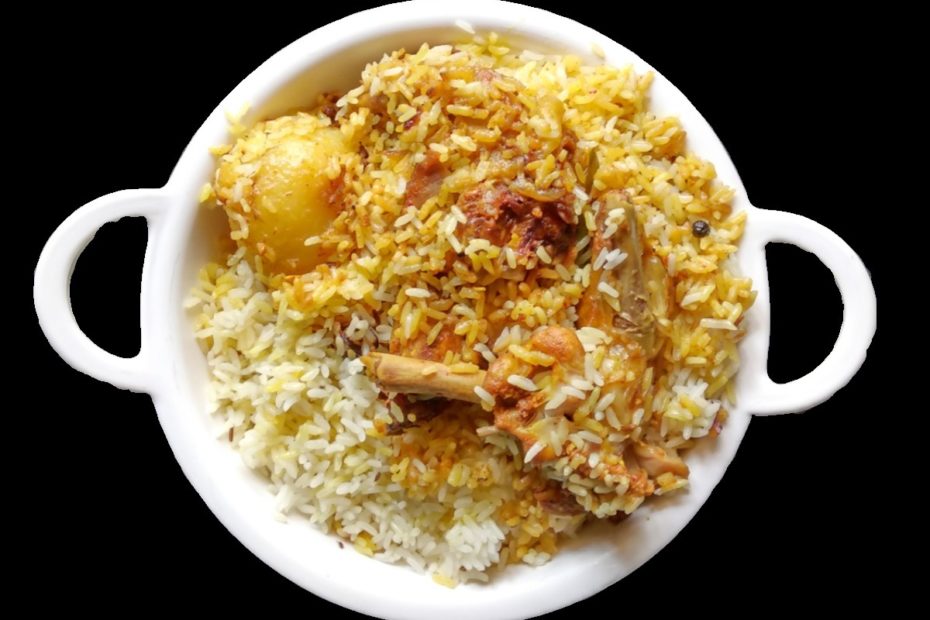About The Author
Hello! From Chuchura (in Hooghly District) and a foodie, I created this blog with a mission to preserve the food of the land; with a message to encourage and promote clean and real food. I hope you enjoy and gain out of this blog, happy reading!
Looking forward to read and hear your feedback.
A kachhi style biryani which is fragrant, has a subtle flavor with pleasant aroma. Ticks all the right check boxes and uses the most popular, very commonly used, indigenous rice to Bengal known as Gobindobhog. A must try if you are looking for a unique biryani that will earn you appreciation.
I am not a big fan of Kolkata Biryani.
The chicken isn’t as juicy as Hyderabadi biryani, and the rice appears rather dry. There is mostly an overdose of aromatics.
So recently I set out on a thought process to create a biryani that I can call as a Bengali Biryani.
You might argue that we already have one. One that you eat out or order from Arsalan, Shiraz, Oudh 1590, Behrouz, Aminia, and so on. And you are very proud of it.
A Kolkata chicken biryani is influenced from its Lucknow counterpart where it is called a pulao. The main highlights of a Kolkata biryani are –
- Long grain basmati rice
- Presence of flavored one-half potato
- Pakki style of cooking
- Use of aromatics like mitha attar, kewra water and rose water
- Delectable non-spicy flavor
In Bangladesh however, the kachhi style of cooking is prevalent.
Difference between Kachhi and Pakki Biryani
In kachhi biryani, the rice is cooked and layered for dum on marinaded meat and the entire product is allowed to cook. In pakki biryani, the rice and meat are both cooked separately and then layered for the final outcome. A great example of kachhi biryani is Hyderabad chicken dum biryani.
The Need for Bengali Biryani is Defining Bangaliana
As of February, 2020, Bengal is India’s leading producer of rice.
However, the state does not produce basmati rice which is mostly grown in northern regions of India.
Combining basmati rice with potato and meat and calling it a Kolkata biryani is perhaps fine since Kolkata is a cosmopolitan city.
However, this leaves the door ajar for a biryani that you can call Bengal’s own – using an aromatic rice that is only produced in Bengal.
Bengal produces quite a few aromatic varieties of rice –
- Gobindobhog
- Radhuni Pagol
- Tulaipanji
I discovered the last two only recently. Gobindobhog chal (or rice) is the most widely availed and used aromatic rice in Bengal (and Eastern India) and hence choosing this variety of rice is natural.
Introducing Bengali Biryani
A Bengali Biryani should be a crowd favorite, and have major ingredients sourced from Bengal. It combines the cooking techniques and flavors across both Bengals – Bengal, India and Bangladesh.
The main features of a Bengali Biryani, conceptualized and implemented in this blog post –
- Use of aromatic Gobindobhog rice
- Use of flavorful potato which is a common vegetable across all veg and non-veg curries in Bengal and Odisha
- Kachhi style cooking which gives a juicier meat
- Use of khoya/mawa (reduced dry milk) to impart a tinge of sweetness
The only challenge is that Gobindobhog is a non-long grain rice and not non-sticky unlike its Dehradun counterpart or basmati rice. Hence oil needs to be added to prevent the rice from sticking to each other while cooking.
Recipe for Bengali Biryani
This is a novel recipe that I have prepared and standardized in my kitchen.

Note
The equipment & ingredient quantity provided in this recipe is to assist you in cooking this dish. Feel free to experiment with your ingredients. Remember that we all have different set, size & shape of kitchen tools in our pantry.
Equipment
- Pressure cooker or cooking pot to dum the biryani
- Pot to cook the rice
- Wok/Kadai to fry onions
- Bowl big enough to prepare the marinade and marinade the chicken overnight
- Ladles
- Serving Plates
Ingredients
- 1 kg chicken on the bone, bigger sizes than normal curry cuts
- 500 g gobindobhog chal (or rice)
- 2 tsp ghee desi ghee is preferred
Whole Spices to Flavor the Rice
- 4 pc cardamom
- 2 pc bayleaf
- 2 pc cinnamon 1 inch stick
- 6 pc cloves
- 8 pc peppercorns
- 1 pc star anise
- 1 pc mace
- 1/2 pc nutmeg
- salt
For the Gobindobhog Biryani Chicken Marinade
- 2 inch ginger
- 10 pcs garlic pods
- 5 pcs green chilies
- 20 g biryani masala store bought, 2-3 tsp
- 1/4 tsp turmeric powder
- 200 g curd beaten well
- 1 tsp salt
- 2 tsp oil
For Cooking the Potatoes & Flavoring Them
- 2 tsp mustard oil
- 2 tsp oil
- 2 pc potato cut into halves
- 1/4 tsp turmeric powder
- water
- salt
- 2 pc cinnamon stick
- 1 pc mace
For the Brown Onions
- 4 pcs medium-sized onions
- 1/2 cup mustard oil
Instructions
Wash and Marinade the Chicken
- Wash the chicken and let the water drain out
- Prepare a paste of ginger, garlic, green chillies
- Take a bowl and prepare a marinade with the ginger, garlic, green chilly paste prepared in the previous step, curd, turmeric powder, salt, biryani masala, and oil
- Ensure that the marinade is consistent and there is no lump
- Pour the marinade over the chicken pieces and massage properly to ensure that marinade is evenly spread.
- Cover and refrigerate overnight or a minimum of 3-4 hours
Pull out the marinaded chicken from the refrigerator and let it thaw for an hour
Cook the Potatoes for Gobindobhog chaler biryani
- In a saucepan or vessel, add the oil
- Prick the potatoes on all sides with a toothpick or fork
- Once the oil starts smoking, add the potatoes
- Add turmeric powder and give it a nice stir
- Saute for 2-3 minutes
- In the same pot, add enough water to cover the potatoes and bring it to a boil
- Add salt and allow it to dissolve in the water
- Taste the water. It should be salty (like sea water). Adjust accordingly
- Add the cinnamon stick and mace
- Boil till the potatoes are cooked. This can take 15-20 minutes
Take gobindobhog chal (rice), wash and keep it soaked for minimum 30 minutes and maximum 45 minutes
Prepare the Brown Onions
- Thinly slice the onions
- In a wok or kadai, pour oil and once the oil is hot, drop the onions
- Fry till the onion is golden brown
- Keep aside in a bowl
Cook the Rice till 70% Done
- In a pot, add water and allow the water to come to a boil
- Once the water boils, add salt and all the whole spices mentioned under "Whole Spices to Flavor the Rice"
- Check if the water is salty. If not, add more salt to ensure that the water is seasoned properly. It should taste like sea water
- Drain and add the rice. Keep a careful eye as the rice cooks faster
- Drain the rice and keep aside once it is 70% cooked
Layering the Rice and Chicken and Preparing for Dum
- In a biryani pot, brush some ghee at the bottom
- Add the marinaded chicken and ensure that part of every chicken piece touches the bottom of the pot. Add in the potato
- Add some brown onions, chopped coriander and mint leaves on top
- Carefully toss half of the rice on top of this
- Repeat by adding some brown onions, chopped coriander and mint leaves
- Toss rest of the rice
- Add the remaining brown onions
- Drizzle ghee on top
- Close the lid and seal the pot
- Cook on high for 10 minutes
- Cook on low flame for around 20 minutes
- Switch off the flame
Allow to Rest and Serve Hot
- Allow the covered pot to rest for another 10 to 15 minutes
- Carefully lift the lid and serve hot with a wedge of lemon and sliced onions
Notes
- Gobindobhog rice should be cooked with oil to avoid the rice from sticking and creating a lump
- While buying the rice for gobindobhog chaler biryani, ensure that you buy aged rice for best results
- The rice has a subtle and pleasant aroma, so do not overload the biryani with a lot of spices

Ending Notes
This is a novel recipe that can be scaled up and adopted as a Bengali biryani recipe by restaurants in and around the region.
Why don’t you give this recipe a try this weekend? It’s a class apart and very flavorful. No artificial essence, no aromatics – the rice and chicken does a wonderful jugalbandi to transform your Sunday lunch into something new, something magical.
And do share your feedback with me through the comments and ratings.


Pingback: Chicken Yakhni Pulao Using Bengali Gobindobhog Rice - FinallyFoodie.com
Where in the layering process does the potato come in? Also, can I use Radha Tilak rice instead of the one you have mentioned? If yes, then will the quantity of rice for Radha tilak vary if I want to use 1kg chicken?
The potato goes at the bottom along with the chicken. I have never tried radha tilak rice, it would be a nice experiment for you to try out and share with me. On the amount of rice, you can go ahead with the same quantity. Normally in a biryani, the meat to rice ratio varies from 1:1 to 2:1.
Alright, thanks.
And, sure, I’ll let you know how the Radha Tilak rice works with this recipe.